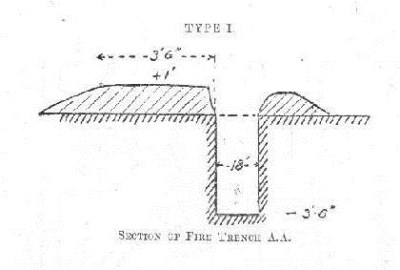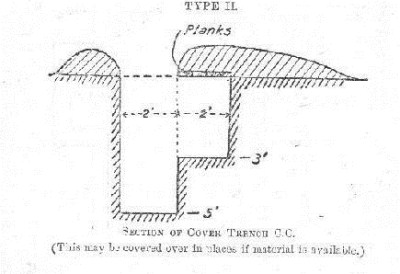The Trench System 1914
Trenches and Field Defences in 1914
Measurements
The measurements on these diagrams are given in feet and inches so 3' 6" means 3 feet 6 inches. There are 12 inches in one foot. Three feet is just under one metre and one foot is about 30 cm.
The System
 The diagram of the trench system shown on the left shows 'traverses' which are changes in direction in the trench line ( a sort of square zigzag) which would happen approximately every four yards (4m). Fire and cover trenches did not go in long straight lines. This reduced the effects of an explosion in the trench and meant that the enemy could not fire far along the trench. The walls of trenches would be reinforced (revetted) with wood or other materials to stop them blowing in and collapsing under shellfire.
The diagram of the trench system shown on the left shows 'traverses' which are changes in direction in the trench line ( a sort of square zigzag) which would happen approximately every four yards (4m). Fire and cover trenches did not go in long straight lines. This reduced the effects of an explosion in the trench and meant that the enemy could not fire far along the trench. The walls of trenches would be reinforced (revetted) with wood or other materials to stop them blowing in and collapsing under shellfire.
According to the Regimental historian:
 The Type 1 fire trench on the right (the type shown at the top of the diagram above) is quite narrow given that it would have to hold a soldier with all his equipment. The enemy side would be to the left; there is a one foot parapet. There is another earth bank behind the trench (the parados) to stop back blast from enemy shells. As the depth below ground is 3 foot 6 inches and the parapet is one foot above ground, the total cover was 4 foot 6 inches about 1,4 m). An average man might be 5 foot 8 inches high (about 1.72 metre ). Many soldiers were shot in the head by snipers because they accidentally showed their heads above the parapet.
The Type 1 fire trench on the right (the type shown at the top of the diagram above) is quite narrow given that it would have to hold a soldier with all his equipment. The enemy side would be to the left; there is a one foot parapet. There is another earth bank behind the trench (the parados) to stop back blast from enemy shells. As the depth below ground is 3 foot 6 inches and the parapet is one foot above ground, the total cover was 4 foot 6 inches about 1,4 m). An average man might be 5 foot 8 inches high (about 1.72 metre ). Many soldiers were shot in the head by snipers because they accidentally showed their heads above the parapet.
 A Type 2 cover trench might be behind the fire trench (seen at the bottom of the first diagram). These could also be traversed but would be deeper. The diagram to the left shows them 5 feet deep with a covered recess for sitting or sleeping which would be 3 feet deep. The cover recess would be on the enemy side.
A Type 2 cover trench might be behind the fire trench (seen at the bottom of the first diagram). These could also be traversed but would be deeper. The diagram to the left shows them 5 feet deep with a covered recess for sitting or sleeping which would be 3 feet deep. The cover recess would be on the enemy side.
The Type 3 communication trench shown on the right connected the front line fire trenches to the cover trenches. At a width of 18 inches at the bottom an possibly full of mud, it would be very difficult to carry stores up to the line and the wounded back and even more difficult if the men going forward had to pass the men going back. These trenches were deeper so that men could walk upright. Often, because of flooding or congestion, soldiers took the risk of crossing open ground instead of using the communication trench.
Latrines It was not just the fighting positions and communication trenches which needed digging but the more prosaic everyday requirements of Latrines (Toilets). Similar examples are still used today on active service.
The source of the diagrams on this page is the Army Publication 'Notes on Field Defences - 1914'.
Previous page: The CO and the grenade
Next page: Late Spring 1915

